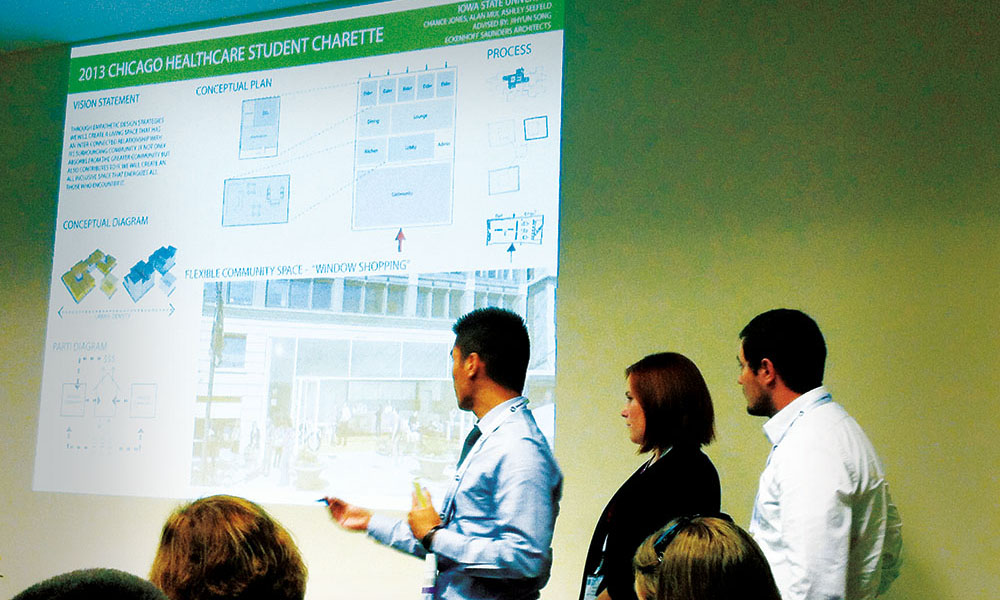The concept of “generative space” was developed in 2003. Since then, the research-based concept has given birth to a new generation of facilities that share one common element — they are places of flourishing for the full spectrum of users.
Generative space is an environment where the experience of participants fulfills the functional requirements of that space and it also materially improves the health, healthcare and quality of life for those participating in that experience. It is a place that progressively and tangibly improves over time.
In pursuing the purpose of The CARITAS Project, which is: “pioneering the next generation of improvements in health and healthcare delivery through innovative design of the environment,” an eye-opening discovery was made. It became evident that most healthcare facility environments deteriorate over time, to the degree that — after a certain period of time — it becomes necessary to repair or replace the environmental components.
In stark contrast, it was observed that a very small number of facilities actually improved over time. Why does this happen? And, how can we learn from those that do improve, so that it becomes possible to design all facilities to improve?
By actively exercising health design leadership to cultivate a more generative space to create “a place to flourish,” it creates both systemic and sustainable improvements to lives, organizations and communities. In the 11 years that have passed since the concept of generative space for healthcare was developed, individuals around the globe have been learning how to apply this new design approach to create places for flourishing.
Influencing the future is not a simple project, and it does not happen quickly — especially within the healthcare industry. Nevertheless, with 11 years of “equity”— as well as a growing body of knowledge and exemplars — it is only a matter of time until generative space design becomes the next best practice and is considered mainstream.
Generative space 2013
Each year, the Healthcare Facilities Symposium & Expo offers a range of programs that provide learning resources about generative space. These include the pre-conference workshop, the Generative Space Track and the Generative Space Award. In 2013, the first annual Generative Space Week was launched with its programs being offered in Chicago, Ill. The Chicago-based programs are independent of the HFSE, although some of the programs were provided during the HFSE and were featured as special events.
Specifically, Generative Space Week 2013 consisted of two events — the AIA Student Design Charrette, and the premiere of a “Prescription for Happiness” performance. The design charrette was a partnership between the Chicago AIA Healthcare Knowledge Community, the Chicago AIA and The CARITAS Project. It brought five universities together, in Chicago, with funding provided from local industry partners and support from design firms. Each university sent one faculty advisor and three students to learn about generative space and to apply learning to a pre-assigned generative space design challenge.
The charrette began two days prior to the HFSE, with each participant being provided with full complimentary access to the entire event, as well as the opportunity to present designs in specially featured programs. A display area was dedicated for the finished design projects to be viewed by all HFSE attendees. The complete learning experience lasted for six days.
Dr. Mark Rowe, a medical doctor from Waterford, Ireland attended the HFSE to receive a Generative Space Award for Waterford Health Park (www.whp.ie). For five years, Dr. Rowe has been participating in the Leading by Design project, which is an independent research project. Currently, there are 13 individuals from five countries working to learn about generative space.
As Dr. Rowe has become distinguished in leading world health, and discovering effective ways to accomplish generative space, he has authored and scripted a life-enhancing performance, called a “Prescription for Happiness.”
The first formal presentation of this performance was presented at the Garter Lane Theatre, in Waterford, in October 2013. On the occasion of Dr. Rowe being in Chicago to receive the Generative Space Award, he offered to present the world premiere of his performance to a small, supportive audience during Generative Space Week 2013.
The generative space design method involves learning 22 themes through direct personal experience. The learning of these themes is supplemented with 16 diagrams, suggested readings and an invitation to participate in a four-day long annual learning collaborative, where the participants share learnings and — in doing so — learn from each other’s experiences.
Looking ahead
Soon, online courses for generative space design will be available at AECKnowledge.com. This suite of introductory courses can be taken with a quiz following each, and a certificate of completion is provided when a passing grade is achieved on the quiz.
The primary focus of the learning of generative space is on the individual’s leadership effectiveness, rather than accomplishments. Each learner begins a lifelong journey toward mastery. There is no arrival, no final destination; it is a commitment to a practice of learning and improving. The accomplishments merely become the backdrop for more practice, deeper learning opportunities and further improvements.
In learning how to advance one’s leadership effectiveness, this learning transcends knowing about generative space — indeed, this learning requires that one actually becomes generative space, and this quality of ‘being’ informs all of the situations and experiences within life’s contexts: one’s personal life, professional work and community engagements.
If the past 11 years of systemic and sustainable improvements with generative space are any indication of what we might expect to see more of in the future, we can certainly look forward to a much brighter era ahead. Flourishing places will become the norm, with unprecedented expressions of enhanced human vitality, organizational performance and overall community well-being being unleashed as its natural consequence.
To learn more, visit thecaritasproject.info.





